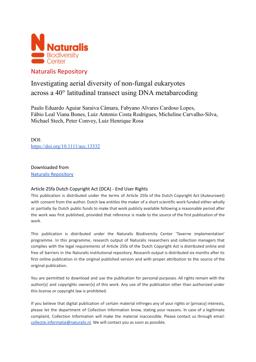2023-04-20
Investigating aerial diversity of non‐fungal eukaryotes across a 40° latitudinal transect using DNA metabarcoding
Publication
Publication
Austral Ecology , Volume 48 - Issue 6 p. 1178- 1194
The high number of bipolar and widespread bryophyte and microbial taxa in the Antarctic flora suggests the effective Long-Distance Dispersal (LDD) of spores and other propagules from lower latitudes and even the Northern Hemisphere to Antarctica and the sub-Antarctic regions. However, few studies have attempted to document the transfer mechanisms by which potential newcomers may arrive in Antarctica. Commonly suggested or assumed mechanisms include transport in air currents, adventitious transfer with migrating or vagrant birds, and with human assistance. In this study, we investigated the biodiversity present in the air along a 40° latitudinal transect, from the port city of Rio de Janeiro, Brazil (ca. 22°S) to Comandante Ferraz Station on King George Island (South Shetland Islands, ca. 62°S), maritime Antarctica, to shed light on the potential role of LDD in species distribution. Air samples were collected in October 2021 on the Brazilian polar support vessel Ary Rongel using air filters with membranes of 0.22 μm. Total DNA was extracted from the filters and the Internal Transcribed Spacer (ITS2) DNA sequence was used for metabarcoding. A total of 53 non-fungal taxa representing three kingdoms (most abundantly Viridiplantae) and six phyla (most abundantly Bryophyta and Magnoliophyta) were assigned from the sequences found. Aerial biodiversity was greater closer to the coast and generally decreased with increasing latitude, although a small increase was apparent in the South Shetland Islands. The taxa assigned are generally present in coastal biomes, although a small proportion of the assignments represented taxa of more distant origin, supporting the occurrence of LDD in the air column.
| Additional Metadata | |
|---|---|
| , , , , | |
| doi.org/10.1111/aec.13332 | |
| Austral Ecology | |
| Organisation | Staff publications |
|
Câmara, Paulo Eduardo Aguiar Saraiva, Lopes, Fabyano Alvares Cardoso, Bones, Fábio Leal Viana, Rodrigues, Luiz Antonio Costa, Carvalho‐Silva, Micheline, Stech, M., … Rosa, Luiz Henrique. (2023). Investigating aerial diversity of non‐fungal eukaryotes across a 40° latitudinal transect using DNA metabarcoding. Austral Ecology, 48(6), 1178–1194. doi:10.1111/aec.13332 |
|
